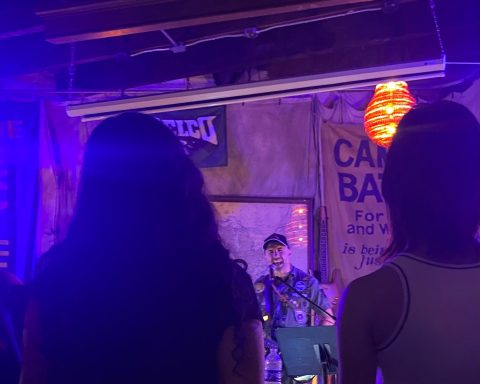In the post-COVID era, the art of dressing well seems to have slowly and sadly started to fade into antiquity. No longer are the schools of America flooded with fashion-forward students determined to dress their best. Chic jeans and sweaters are disappearing, replaced with pajama pants and slide shoes. However, such is not the case at Swarthmore. Many students enjoy expressing their eclectic tastes and personal style through clothing. Like their peers, the first years featured in this article “articulate parts of [their] identity” through their outfits.
Ash Abbott ’29 (first image) is a prospective biology and Asian studies major. They describe their style as “a fun dichotomy of alt and cottagecore.”
Sunny Haig ’29 (second image) is undecided on a major, but is considering engineering, linguistics, or biology. They describe their style as “somewhere between punk and that random critter you saw out by your trash can.”
For these two first years, their outfits are a nonlinguistic representative of who they are as people. Style itself is an inherently subjective thing, meant as a form of self expression or conveying of emotion. Certainly, there are labeled aesthetics, but on the whole it is nearly impossible to fully embody one singular genre. Neither of the two first years could narrow their personal style down to a single word, nor can entire eras be reduced to mere phrases. Though we can imagine what the “punk” aesthetic looks like, there are no concrete rules that immediately qualifies something as being punk or not. Haig stated that they wear a lot of neutral tones (greens, blacks, and browns), yet that cannot be described as their style because colors alone don’t make up fashion. It is, through and through, an extremely individualistic undertaking. Day by day, look by look, people carve out little niches of self expression.
This is made apparent in the numerous ways people approach building an outfit. Some choose to focus on comfort or maneuverability above all. Others mix and match patterns in an attempt to construct an interesting look. There is also the option to utilize a focal point — perhaps a jacket with a loud pattern, or a pair of pants with a quirky shape. Jewelry and adornments serve to liven up a look or tie an outfit together. Haig mentions often wearing chokers and necklaces in tandem with combat boots, seemingly a staple in their closet. They themselves “prioritize comfort and also thrift most of [their] clothing.”
Meanwhile, Abbott touches upon accessories in the context of identity: Where using certain add-ons can announce affiliations or whether or not someone belongs to a specific community. While it’s important not to immediately assume identity based on clothing, for a lot of people, clothing serves as a visual beacon for those similar to themselves. Examples include many lesbians wearing carabiners or the ‘tech bro uniform’ (i.e. a pristine Patagonia vest paired with a ratty T-shirt and jeans). Abbot also speaks of more explicit accessories, such as pronoun pins or a OneCard lanyard with a beloved fictional character on it. An old T-shirt from high school serves the same purpose in highlighting where you are from and connecting you to the other students who also possess that same shirt. Abbot describes style as “another way to connect and communicate with people” or another way for them to show themselves “without having to verbalize [their] interests and personality to everyone [they] meet.” In this way, an outfit serves as a physical manifestation of the mind of the person wearing it.
With the Class of 2029 dressing so well, Swarthmore College’s fashion future is in good hands.

















